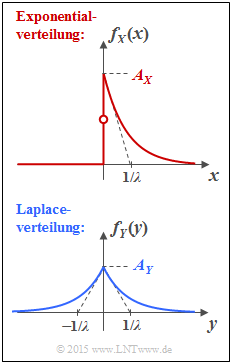Difference between revisions of "Aufgaben:Exercise 4.1Z: Calculation of Moments"
(Die Seite wurde neu angelegt: „ {{quiz-Header|Buchseite=Informationstheorie/Differentielle Entropie }} right| Die Grafik zeigt oben die Wahrscheinlichkeits…“) |
|||
| Line 21: | Line 21: | ||
<quiz display=simple> | <quiz display=simple> | ||
| − | { | + | {Wie groß ist der Maximalwert <i>A<sub>X</sub></i> der WDF <i>f<sub>X</sub></i>(<i>x</i>)? |
|type="[]"} | |type="[]"} | ||
| − | - | + | - <i>A<sub>X</sub></i> = <i>λ</i>/2, |
| − | + | + | + <i>A<sub>X</sub></i> = <i>λ</i>, |
| + | - <i>A<sub>X</sub></i> = 1/<i>λ</i>. | ||
| + | {Wie groß ist der Maximalwert <i>A<sub>Y</sub></i> der WDF <i>f<sub>Y</sub></i>(<i>y</i>)? | ||
| + | |type="[]"} | ||
| + | + <i>A<sub>Y</sub></i> = <i>λ</i>/2, | ||
| + | - <i>A<sub>Y</sub></i> = <i>λ</i>, | ||
| + | - <i>A<sub>Y</sub></i> = 1/<i>λ</i>. | ||
| + | |||
| + | |||
| + | {Gibt es ein Argument <i>z</i>, so dass <i>f<sub>X</sub></i>(<i>z</i>) = <i>f<sub>Y</sub></i>(<i>z</i>) gilt? | ||
| + | |type="[]"} | ||
| + | + Ja. | ||
| + | - Nein. | ||
| + | |||
| + | |||
| + | {Welche Aussagen gelten für die Kenngrößen der Exponentialverteilung? | ||
| + | |type="[]"} | ||
| + | + Der lineare Mittelwert ist <i>m</i><sub>1</sub> = 1/<i>λ</i>. | ||
| + | + Der quadratische Mittelwert ist <i>m</i><sub>2</sub> = 2/<i>λ</i><sup>2</sup>. | ||
| + | + Die Varianz ist <i>σ</i><sup>2</sup> = 1/<i>λ</i><sup>2</sup>. | ||
| − | { | + | {Welche Aussagen gelten für die Kenngrößen der Laplaceverteilung? |
| + | |type="[]"} | ||
| + | - Der lineare Mittelwert ist <i>m</i><sub>1</sub> = 1/<i>λ</i>. | ||
| + | + Der quadratische Mittelwert ist <i>m</i><sub>2</sub> = 2/<i>λ</i><sup>2</sup>. | ||
| + | - Die Varianz ist <i>σ</i><sup>2</sup> = 1/<i>λ</i><sup>2</sup>. | ||
| + | |||
| + | {Mit welcher Wahrscheinlichkeiten unterscheidet sich die Zufallsgröße <nobr>(<i>X</i> bzw. <i>Y</i>)</nobr> vom Mittelwert <i>m</i> betragsmäßig um mehr als die Streuung <i>σ</i>? | ||
|type="{}"} | |type="{}"} | ||
| − | $ | + | $Exponential: Pr(|X – mX| > σX)$ = { 0.135 3% } |
| − | + | $Laplace: Pr(|Y – mY| > σY)$ = { 0.243 3% } | |
Revision as of 12:38, 20 March 2017
Die Grafik zeigt oben die Wahrscheinlichkeitsdichtefunktion (WDF) der Exponentialverteilung: $$f_X(x) = \left\{ \begin{array}{c} A_{ X} \cdot {\rm exp}(-\lambda \cdot x) \\ A_{ X}/2 \\ 0 \\ \end{array} \right. \begin{array}{*{20}c} {\rm{f\ddot{u}r}} \hspace{0.1cm}x>0, \\ {\rm{f\ddot{u}r}} \hspace{0.1cm}x=0, \\ {\rm{f\ddot{u}r}} \hspace{0.1cm}x<0. \\ \end{array}$$ Darunter gezeichnet ist die WDF der Laplaceverteilung, die für alle y–Werte wie folgt angegeben werden kann: $$f_Y(y) = A_{ Y} \cdot {\rm exp}(-\lambda \cdot |y|)\hspace{0.05cm}.$$ Die zwei wertkontinuierlichen Zufallsgrößen X und Y sollen hinsichtlich der folgenden Kenngrößen verglichen werden:
- dem linearen Mittelwert m1 (Moment erster Ordnung),
- dem Moment zweiter Ordnung ⇒ m2,
- der Varianz σ2 = m2 – m12 (Satz von Steiner), und
- der Streuung σ.
Hinweis: Die Aufgabe gehört zum Kapitel 4.1 des vorliegenden Buches. Sie fasst gleichzeitig die erforderlichen Vorkenntnisse von Kapitel 3 des Buches „Stochastische Signaltheorie” zusammen. Gegeben sind außerdem die beiden unbestimmten Integrale: $$\int \hspace{-0.01cm} x \cdot {\rm e}^{-\lambda \hspace{0.05cm}\cdot \hspace{0.05cm}x}\hspace{0.1cm}{\rm d}x = \frac{{\rm e}^{-\lambda \hspace{0.05cm}\cdot \hspace{0.05cm}x}}{(-\lambda)^2}\cdot(-\lambda \cdot x-1)\hspace{0.05cm}, $$ $$\int \hspace{-0.01cm} x^2 \cdot {\rm e}^{-\lambda \hspace{0.05cm}\cdot \hspace{0.05cm}x}\hspace{0.1cm}{\rm d}x = {\rm e}^{-\lambda \hspace{0.05cm}\cdot \hspace{0.05cm}x}\cdot (\frac{x^2}{-\lambda} - \frac{2x}{\lambda^2} + \frac{2}{\lambda^3}) \hspace{0.05cm}. $$
Fragebogen
Musterlösung
